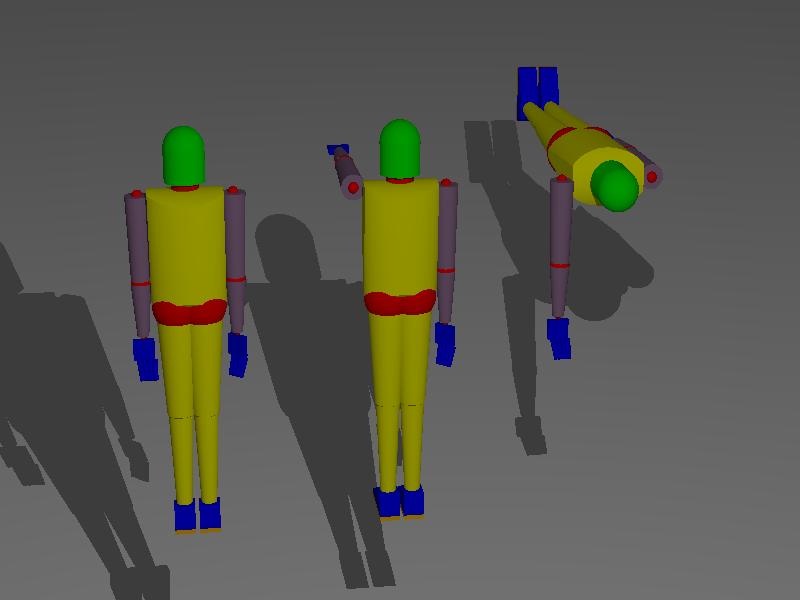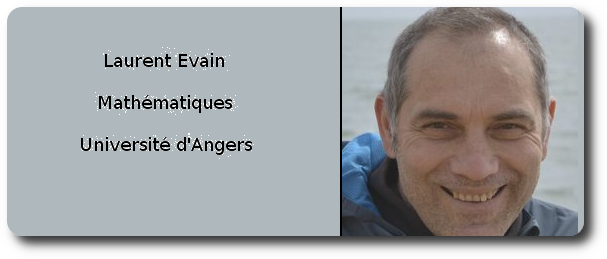Bodies and Skeletons¶
Bodies¶

To check that the size of an object is compatible with a human body, we can use the body primitive. The body has a crude appearance ( we shall see later how to ameliorate it ) but it is quite parametrizable to get precise dimensions. The following code shows the possibie input parameters for the size and the instructions to move the joints of the body.
When moving an articulation, you can choose to move it the standard way or in the reverse way. For instance, using the shoulder, usually we move the arm. But, in some exotic situation, it may happen the using the shoulder, the arm stays fixed and the rest of the body moves (for instance hanging rings in a gymnastice exercise). For each joint, there is a side used by default, and an other side used if we set the option “toggleJoint”.
- The list of joints in the body is“leftAnkle”,”rightAnkle”,”leftKnee”,
“rightKnee”, “leftPelvis”, “rightPelvis”, “neck”, “leftShoulder”, “rightShoulder”, “leftElbow”, “rightElbow”, “leftWrist”, “rightWrist”.
import armature
from armature import *
g=plane(Z,origin-Z).colored("Grey")
body1=Body(topHeadHeight=1.805,
armup=2.34, # the height of the end of the nails, when the arm is up
armdown=.69,# the height of the end of the nails, when the arm is down
topShoulder=1.54, #the height above the shoulder
bottomMentonHeight=1.57,
headCirconference=.6,
neckCirconference=.4,
leftRightLegAxes=.12,# the distance between the legs axes, when they are parallels.
leftRightArmAxes=.44, # idem for the arms
wristFinger=.22,# full distance from the wris to the end of the nails, when the wrist is bent at 90 degrees
elbowWrist=.325,# full distance from the wris to the elbow, when the wrist is bent at 90 degrees
elbowFinger=.51,# lower arm, including elbow,
belowElbow=1.105,#, the height below the elbow, when the elbow is bent at 90 degrees horizontally
ankleHeight=.1,# the height of the proeminent point of the ankle
ankleWidth=.065,# measured at the proeminent points of the ankle
lowerLeg=.58, #ground to above the knee, when sit on a chair
upperLeg=.67, #distance from the back to to above the knee, when sit on a chair
leg=1.14,# sit on the ground, the back on a wall, distance from the wall to the foot arches
upperBody=.63, #height of the top of a shoulder, when sit on the ground
footSize=[.10,.28,None],
shoeSole=.02, # thickness of the sole
yDistanceAnkleToe=.2,# horizontal distance from the center of the ankle to the end of nails
handWidth=.1,
handThickness=.025,
tibiaLowerCirconference=.24,
tibiaUpperCirconference=.37,
femurLowerCirconference=.4,
femurUpperCirconference=.62,
humerusLowerCirconference=.28,
humerusUpperCirconference=.36,
cubitusLowerCirconference=.175,
cubitusUpperCirconference=.30,
trunkLowerCirconference=.9,
trunkLowerWidth=.35,
trunkUpperCirconference=1.03)
body2=Body().translate(X)
body2.bend.leftShoulder(1.6,X) # arguments=(angleInRadians,axisVectorForTHeRotation)
body3=Body().translate(2*X)
body3.bend.leftShoulder(1.6,X,toggleJoint=True)
Skeletons¶
For a nice looking picture, the above crude body is not sufficient. There is a Skeleton class in Pycao to easily define bodies different from the default body or more generally other skeletons.
A skeleton in real life is a set of bones linked together by some joints. To prescribe the position of a skeleton, we have to take care that each bone has to stays linked to its joints. The “Skeleton” class helps to achieve this goal.
To move a skeleton, we act with our muscles on the joint, and this is what we mimic in Pycao. To indicate that we should by default move the arm rather than the rest of the body, we say that the bone in the arm is the child whether the bone in the trunk is the parent.
In pycao, when a muscle acts on the joint of a Skeleton, the child bone moves (together with its descendants, as usual). Or to say it differently, all the bones and the joints which are on the child side of the joint move simultaneaously. For instance, acting on a shoulder, the whole arm moves ( the humerus moves, and the radius and the hand follow the movement, because they are children).
There is an ancestor in the genealogy, which is usually chosen to be the heavier bone of the body. The genealogy is determined by the ancestor and the way the bones are connected. The order we meet the bones defines the genealogy. For instance, if we choose the trunk to be the ancestor of the human body, then we first meet a leg, which is a child of the trunk, then a foot, which is a child of the leg.
To declare a skeleton, we have to indicate
the names of the bones , and for each name of a bone, an object to represent it in the 3D-picture
the names of the joints,
for each joint name
the name of the 2 bones connected,
the default position for the center of the joint
the object used to represent it
The bone which is the ancestor of all the other bones.
Here is for instance a sequence of code used in the declaration of the above body. We have prealably constructed objects leftFoot,rightFoot,etc…, and then the body is constructed with the following instructions.
bones=[["leftFoot",leftFoot],["rightFoot",rightFoot],["leftTibia",myTab["leftTibia"]],["rightTibia",myTab["rightTibia"]],["leftFemur",myTab["leftFemur"]],["rightFemur",myTab["rightFemur"]],["trunk",trunk],["head",head],["leftHumerus",myTab["leftHumerus"]],["rightHumerus",myTab["rightHumerus"]],["leftCubitus",myTab["leftCubitus"]],["rightCubitus",myTab["rightCubitus"]],["leftHand",leftHand],["rightHand",rightHand]]
joints=[
["leftAnkle","leftFoot","leftTibia",myTab["leftAnkle"].center,myTab["leftAnkle"]],
["rightAnkle","rightFoot","rightTibia",myTab["rightAnkle"].center,myTab["rightAnkle"]],
["leftKnee","leftTibia","leftFemur",myTab["leftKnee"].center,myTab["leftKnee"]],
["rightKnee","rightTibia","rightFemur",myTab["rightKnee"].center,myTab["rightKnee"]],
["leftPelvis","leftFemur","trunk",myTab["leftPelvis"].center,myTab["leftPelvis"]],
["rightPelvis","rightFemur","trunk",myTab["rightPelvis"].center,myTab["rightPelvis"]],
["neck","head","trunk",neck.center,neck],
["leftShoulder","leftHumerus","trunk",myTab["leftShoulder"].center,myTab["leftShoulder"]],
["rightShoulder","rightHumerus","trunk",myTab["rightShoulder"].center,myTab["rightShoulder"]],
["leftElbow","leftCubitus","leftHumerus",myTab["leftElbow"].center,myTab["leftElbow"]],
["rightElbow","rightCubitus","rightHumerus",myTab["rightElbow"].center,myTab["rightElbow"]],
["leftWrist","leftHand","leftCubitus",myTab["leftWrist"].center,myTab["leftWrist"]],
["rightWrist","rightHand","rightCubitus",myTab["rightWrist"].center,myTab["rightWrist"]]]
ancestor="trunk"
Skeleton.__init__(self,joints,bones,ancestor)
